 |
|||||||||||||||||||||||||||
 |
 |
 |
 |
 |
 |
||||||||||||||||||||||
 |
Herb of the Season: Mullein
|
||||||||||||||||||||||||||
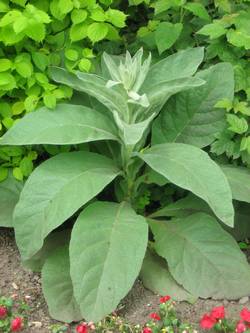 This breathtaking herb reminds me of royalty…even the Latin name “Verbascum thapsus” has a regal air! In the first year of growth, anytime from spring until fall, a crown of thick furry flannel-like leaves grows in a layered rosette. In the second year the crown of leaves grows majestically up from the ground. Around the summer solstice, mullein sends up a long slender spire and gradually adorns it with bright yellow flowers. Verbascum is a visual delight and a beautiful addition to both wild and cultivated gardens. Mullein attracts a wide variety of pollinators including bees and butterflies whose survival is threatened as their natural food sources are replaced by exotic foreign plants, large weed-free lawns and expanding urbanization. Mullein loves dry, sunny conditions and relatively poor soil, making it perfect for a drought-resistant garden! 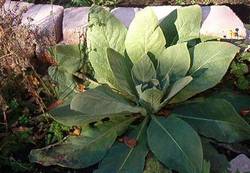 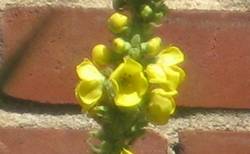
Mullein leaves have been used throughout history as a tonic* for the entire respiratory system as well as an herbal remedy to relieve bronchiole congestion, asthma attacks or a deep, dry cough. They should be harvested before the plant flowers. Gather the grey-green leaves after a couple sunny days and hang them individually or lay them out in baskets so they can dry to a very brittle state. Mullein leaf infusion (visit the Herbal Health Root for preparations) nourishes the respiratory system thanks to its astringent*, demulcent* and anti-asthmatic* qualities. Drink a cup or two of mullein leaf infusion daily to soothe your cough or congested lungs or add it to your regular infusion of nettle or oat straw as preventative medicine. Wise Woman and herbal educator Susun Weed suggests making a mullein latte before allergy season to support our immune and respiratory systems. Simply infuse the dried mullein leaf (1 ounce per liter of boiling water in a mason jar) overnight (it’ll get very dark) and then add half part of organic milk to the infusion. She advises drinking it daily for six weeks. If this sounds like a solution for you start gathering mullein leaves in abundance now! Be sure to strain your mullein leaf infusion through a coffee filter or clean cloth in order to remove the tiny hairs on the leaves which may irritate your throat or lungs. (These fiberglass-like hairs are also why mullein is not recommended as “nature’s toilet paper” as I was once taught!) 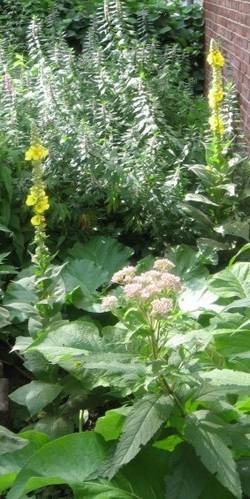 Natives taught the early settlers about the many virtues of smoking mullein leaf, as they had, in order to protect their lungs from their smoky environment. Several studies have supported the expectorant*, and anticatarrhal* effects of mullein. The taste of mullein, dried, crumbled and smoked in a pipe, is a lot like American tobacco but instead of the negative effects associated with smoking tobacco, mullein actually improves respiratory function. (It’s not easy to get our heads around that concept in our anti-smoking culture!) Mullein leaves can also be tied together in a bundle, or smudge stick. The smoke from the burning smudge can be inhaled for the same benefits. My friend Nicole tinctures mullein leaves in alcohol and has been impressed with the relief it has brought to her family’s chest colds and unrelenting coughs. If children are going to be taking this remedy you could also infuse the chopped mullein leaf in pure vegetable glycerin instead of alcohol for toning the mucous membranes of the respiratory system. 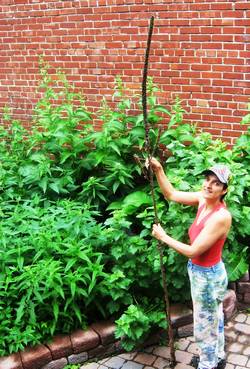 In medieval times mullein stalks were immersed in suet or wax and used as torches.(If you try making your own mullein torch be sure to place it in a pail of sand or in the ground so as not to be burned by melting wax or sputtering suet!) Natives valued the length and strength of the dried mullein stalk as a hand-drill when making friction fires. A hand drill has two parts: a fireboard, which is a flat piece of wood, (ideally cedar) with a small depression carved into it; and a spindle, the straight, narrow stalk of the dried mullein, whose end fits into the depression on the fireboard. To create a spark, rub the spindle rapidly between your hands, or using a bow, in order to produce enough friction to get past the smoke stage. Have a tinder bundle ready to light your coal. With a good amount of force, endurance and speed mullein stalks can help you stay warm in a survival situation. I leave the stalk standing in my wild garden over the winter hoping that several seeds will sprout in the spring. No matter how many seeds may fall Verbascum always seems to prefer growing on my front lawn where there’s a generous supply of carbon monoxide.. a favourite food source according to Susun. I agree with her theory as I enjoy the stunning sight of multitudes of mullein plants growing along the highway in July and August. Even traveling along at 100 km/hr mullein’s yellow crowned stalks grab my attention!
Monica
|
|||||||||||||||||||||||||||
 | |||||||||||||||||||||||||||
|
Over the years I have been blessed with many inspirational teachers. I thank them for sharing their wisdom through their lectures, workshops, websites and books. For more information about Mullein and many other healing herbs, enjoy these insightful and informative resources. | |||||||||||||||||||||||||||
| Opening our Wild Hearts to the Healing Herbs by Gail Faith Edwards |
(Ash Tree Publishing, 2000) Click for website |
||||||||||||||||||||||||||
| Stalking the Healthful Herbs by Euell Gibbons |
(Alan C. Hood & Co., Inc, 1966) Click for website |
||||||||||||||||||||||||||
The Medicinal Garden by Anne McIntyre |
(Henry Holt & Company, 1997) Click for website | ||||||||||||||||||||||||||
| “Take a Deep Breath” Workshop with Susun Weed at the Wise Woman Center |
(Woodstock, NY, 2004) Click for website |
||||||||||||||||||||||||||

|
|||||||||||||||||||||||||||
 ©2025 Monica Giacomin ©2025 Monica Giacomin |
|||||||||||||||||||||||||||